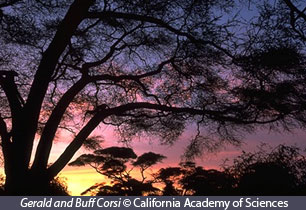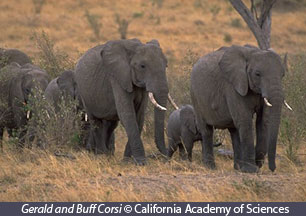|
Location | Weather | Plants | Animals | People | Games | Links
 LOCATION: Savannas
are comprised mostly of grasses and a few scattered trees. They cover
half the surface of Africa, large areas of Australia, South America, and India. That is
a lot of the earth’s surface! Savannas can result from climate changes, soil conditions,
animal behavior, or agricultural practices. Humans create savannas by burning grasslands
and cutting down trees so they can plant crops. Large animals, like elephants, can turn
a forest into a savanna by knocking trees down, stripping the bark from the trees, and tramping
on tree seedlings. LOCATION: Savannas
are comprised mostly of grasses and a few scattered trees. They cover
half the surface of Africa, large areas of Australia, South America, and India. That is
a lot of the earth’s surface! Savannas can result from climate changes, soil conditions,
animal behavior, or agricultural practices. Humans create savannas by burning grasslands
and cutting down trees so they can plant crops. Large animals, like elephants, can turn
a forest into a savanna by knocking trees down, stripping the bark from the trees, and tramping
on tree seedlings.
WEATHER: An important factor in the savanna is climate.
The climate is usually warm and temperatures range from 68° to 86°F (20 to 30°C). Savannas exist
in areas where there is a 6 - 8 month wet summer season, and a 4 - 6 month dry winter season.
The annual rainfall is from 10 - 30 inches (25 - 75 cm) per year. During the dry season, lightning
often strikes the ground, igniting the dry grasses that cover the savanna.
 PLANTS: The savanna is dominated by grasses such as Rhodes grass, red oats grass, star grass, lemon
grass, and some shrubs. Most savanna grass is coarse and grows in patches with interspersed
areas of bare ground. You won’t see many trees in the savanna because of little
rainfall. Occasionally, you’ll find individual trees or small groves of trees. These
mostly live near streams and ponds. The Acacia tree is an interesting plant in the savanna.
It has an umbrella shape, with branches and leaves high off the ground that giraffes like
to eat. Baobab trees also live in the savanna. They deal with dry conditions by storing
water between the bark and meat of the tree. PLANTS: The savanna is dominated by grasses such as Rhodes grass, red oats grass, star grass, lemon
grass, and some shrubs. Most savanna grass is coarse and grows in patches with interspersed
areas of bare ground. You won’t see many trees in the savanna because of little
rainfall. Occasionally, you’ll find individual trees or small groves of trees. These
mostly live near streams and ponds. The Acacia tree is an interesting plant in the savanna.
It has an umbrella shape, with branches and leaves high off the ground that giraffes like
to eat. Baobab trees also live in the savanna. They deal with dry conditions by storing
water between the bark and meat of the tree.
ANIMALS: There are many different types of animals
that live in the savanna. The species found in savannas vary by the geographic location of the biome. Animals native to African savannas
include African elephants, zebras, horses, and giraffes. Many animals in the savanna are
herbivores, which means they eat plants, and there is plenty of grass in the savanna. During
the rainy months animals thrive in the savanna, but the rainy season is only half the year.
During the dry season, surface water from the rain is quickly absorbed into the ground by
thirsty soils. The competition for water during the dry season is so intense that most birds
and many of the large mammals migrate elsewhere in search of water. Depending on the severity
of the drought, the migration may be to a place nearby, or far away. The dry season is often
associated with fires. Many insects with short life spans die in these fires, but the birds
and larger animals are usually able to fly or run to safety. Although small burrowing animals
probably can’t outrun the flames, they often survive the fire by digging deep into
the ground and remaining there until the flames are gone. Some birds, such as the Fork-tailed
Drongos, don’t flee the fires; they actually fly to the fires. For these birds fire
means dinner. They eat the fleeing or flame-roasted insects.
 PEOPLE
AND THE SAVANNA: Some environmental concerns with savannas include poaching or
hunting, overgrazing, and destruction of land for commercial crops. Many animals in the
savanna, such as the rhinoceros and zebra, are endangered and threatened with extinction
due to hunting, poaching, and habitat loss. The savanna is often damaged when it is used
as pastureland for non-native domestic cattle. Cattle grazing also limits the amount of
food available for wildlife. PEOPLE
AND THE SAVANNA: Some environmental concerns with savannas include poaching or
hunting, overgrazing, and destruction of land for commercial crops. Many animals in the
savanna, such as the rhinoceros and zebra, are endangered and threatened with extinction
due to hunting, poaching, and habitat loss. The savanna is often damaged when it is used
as pastureland for non-native domestic cattle. Cattle grazing also limits the amount of
food available for wildlife.
GAMES:
LINKS:
Blue Planet Biomes: Savanna
Enchanted Learning: Savanna Animal Printouts
Smithsonian National Zoological Park: African Savanna for Kids
|

